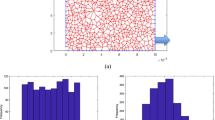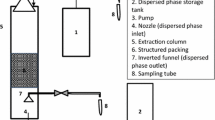Abstract
The application of fully pulsatile flow in liquid-liquid two-phase extraction contributes to augment the interfacial mass transfer. Further, the inclusion of air at the top of the central test section combined with pulsatile flow augments the extraction or the mass transfer process. Toluene-water is chosen as an organic-aqueous two-phase liquid-liquid system with acetic acid as the transfer species which is added in dilute quantities 10 percentage by volume to the organic phase and the transfer of the same to the aqueous phase is recorded with the help of refractive index (RI) measurements. The RI is converted to an overall volumetric mass transfer coefficient with the help of a formula derived for the system. Experiments have been conducted for pulsatile flow with T junction having no air at the top and with variable volume 5, 10, 12, and 14 cm3 of air at the top of the cross junction. The results of mass transfer coefficients were compared and it was found that inclusion of air combined with flow pulsation leads to a higher degree of extraction in comparison to without pulsation and pulsatile flow with no air at the top. Also, the in-phase mode of pulsation with 2.5 Hz of frequency leads to enhanced extraction and a broader plug flow regime.













Similar content being viewed by others
Abbreviations
- k i :
-
Experimental run, [dimensionless]
- h i :
-
Length of toluene plugs in the test window, [m]
- n i :
-
Number of toluene plugs in the test window, [dimensionless]
- L T P :
-
Average plug length, [m]
- U s w :
-
Inlet superficial velocity of aqueous phase i.e. water, [\(\frac {m}{s}\)]
- k o v a :
-
Overall volumetric mass transfer coefficient, [\(\frac {1}{s}\)]
- d N :
-
number of moles per second, [\(\frac {mol}{s}\)]
- U s t :
-
Inlet superficial velocity of organic phase i.e. toluene, [\(\frac {m}{s}\)]
- L P l u g :
-
Length of toluene plug, [m]
- Q w :
-
Flow-rate of the aqueous phase i.e. water, [\(\frac {m^{3}}{s}\)]
- Q T :
-
Flow-rate of the organic phase i.e. toluene, [\(\frac {m^{3}}{s}\)]
- C T :
-
Concentration of acetic acid in organic phase [m3 of acetic acid/ m3 of pure toluene]
- a :
-
Specific inter-facial area, [\(\frac {m^{2}}{m^{3}}\)]
- \(C_{w}^{*}\) :
-
Equilibrium concentration of acetic acid in water in equilibrium with the bulk concentration of acetic acid in toluene \(C_{w}^{*}=m\cdot C_{T}\) (where m is the slope).
- C T,in :
-
Initial concentration of acetic acid in organic phase, [m3 of acetic acid/ m3 of pure toluene] at the inlet.
- C w,in :
-
Initial concentration of acetic acid in aqueous phase, [m3 of acetic acid/ m3 of pure water] at the inlet of the central test section.
- C w,out :
-
Outlet concentration of acetic acid at the aqueous phase [m3 of acetic acid/ m3 of pure water]
- A :
-
Cross-sectional area of the tube/central test section, [m2]
- L :
-
Length of the central test section/tube, [m]
- Q T o t a l :
-
Qw + QT, (Total volumetric flow rate), [\(\frac {m^{3}}{s}\)]
- f T :
-
Frequency of the toluene pump, [Hz]
- f W :
-
Frequency of the water pump, [Hz]
- η T P :
-
Mean frequency, [dimensionless]
- η :
-
Frequency of the toluene plugs in the experimental run, [dimensionless]
- ρ :
-
Density of the phase [\(\frac {Kg}{m^{3}}\)]
- μ :
-
Viccosity of the phase, [Pa-sec]
- \(\sum \) :
-
Summation, [dimensionless]
- λ T :
-
Amplitude of toluene, [m]
- λ w :
-
Amplitude of water, [m]
References
Velazquez A, Arias J, Mendez B (2008) Laminar heat transfer enhancement downstream of a backward facing step by using a pulsating flow. Int J Heat Mass Tran 51(7-8):2075–2089
Hofmann HM, Movileanu DL, Kind M, Martin H (2007) Influence of a pulsation on heat transfer and flow structure in submerged impinging jets. Int J Heat Mass Transfer 50(17-18):3638–3648
Mehta B, Khandekar S (2014) Taylor bubble-train flows and heat transfer in the context of pulsating heat pipes. Int J Heat Mass Transfer 79:279–290
Wang X, Zhang N (2005) Numerical analysis of heat transfer in pulsating turbulent flow in a pipe. Int J Heat Mass Transfer 48(19-20):3957–3970
Nishimura T, Kojima N (1995) Mass transfer enhancement in a symmetric sinusoidal wavy-walled channel for pulsatile flow. Int J Heat Mass Tran 38(9):1719–1731
Krishna BR, Ellenberger J (2002) Improving Gas-Liquid mass transfer in bubble columns by applying Low-Frequency vibrations. Chem Eng Technol 25:200–203
Ellenberger J, Krishna R (2002) Improving mass transfer in gas – liquid dispersions by vibration excitement. Chem Eng Sci 57:4809–4815
Ellenberger J, Krishna R (2003) Shaken, not stirred, bubble column reactors: Enhancement of mass transfer by vibration excitement. Chem Eng Sci 58(3-6):705–710
Waghmare Y, Dorao C, Jakobsen H, Knopf FC, Rice R (2009) Bubble size distribution for a bubble column reactor undergoing forced oscillations. Ind Eng Chem 48(4):1786–1796
Gorak A, Stankiewicz A (2011) Intensified reaction and separation systems. Annu Rev Chem Biomol Eng 2:431–451
Kenig E, Gorak A, Pyhälahti A., Jakobsson K, Aittamaa J, Sundmacher K (2004) Advanced rate-based simulation tool for reactive distillation. AIChE journal 50(2):322–342
Balamurugan V, Subbarao D, Roy S (2010) Enhancement in gas holdup in bubble columns through use of vibrating internals. Can J Chem Eng 88(6):1010–1020
Grinis L, Kholmer V, Korin E (2004) Liquid oxygenation improvement by interaction of bubbles and vibration fields. Chem Eng Technol: Ind Chem-Plant Equip-Proc Eng-Biotechnol 27(11):1206–1211
Grinis L, Kholmer V, Fominykh A (2005) Effect of plate oscillation on bubble residence time in an aerated stagnant liquid. Chem Eng Technol: Ind Chem-Plant Equip-Proc Eng-Biotechnol 28(9):1022–1027
Dessimoz AL, Cavin L, Renken A, Kiwi-Minsker L (2008) Liquid-liquid two-phase flow patterns and mass transfer characteristics in rectangular glass microreactors. Chem Eng Sci 63(16):4035–4044
Dummann G, Quittmann U, Gröschel L., Agar DW, Wörz O. (2003) K. morgenschweis, The capillary-microreactor : a new reactor concept for the intensification of heat and mass transfer in liquid – liquid reactions. Catal Today 80:433–439
Torab-Mostaedi M, Safdari J (2009) Mass transfer coefficients in a pulsed packed extraction column. Chem Eng Process 48(8):1321–1326
Torab-Mostaedi M, Ghaemi A, Asadollahzadeh M, Pejmanzad P (2011) Mass transfer performance in pulsed disc and doughnut extraction columns. Braz J Chem Eng 28(3):447–456
Hewgill M, Mackley M, Pandit A, Pannu S (1993) Enhancement of gas-liquid mass transfer using oscillatory flow in a baffled tube. Chem Eng Sci 48(4):799–809
Chakravorty A (2018) Process intensification by pulsation and vibration in miscible and immiscible two component systems Chemical Engineering and Processing-Process Intensification
Ferreira A, Teixeira JA, Rocha F (2015) O2 mass transfer in an oscillatory flow reactor provided with smooth periodic constrictions. individual characterization of kl and a. Chem Eng J 262:499–508
Ni X, Cosgrove J, Arnott A, Greated C, Cumming R (2000) On the measurement of strain rate in an oscillatory baffled column using particle image velocimetry. Chem Eng Sci 55(16):3195–3208
Jahya A, Stevens G, Pratt H (2009) Pulsed disc-and-doughnut column performance. Solvent Extr Ion Exc 27(1):63–82
Bahmanyar A, Khoobi N, Mozdianfard MR, Bahmanyar H (2011) The influence of nanoparticles on hydrodynamic characteristics and mass transfer performance in a pulsed liquid–liquid extraction column. Chem Eng Process 50(11-12):1198–1206
Chantry WA, Berg RV, Wiegandt H (1955) Application of pulsation to liquid-liquid extraction. Ind Eng Chem 47(6):1153–1159
Soboll S, Kockmann N (2018) Hydrodynamics and mass transfer in a lab-scale stirred-pulsed extraction column. Chem Eng Technol 41(9):1847–1856
Bottausci BF (2004) Mixing in the shear superposition micromixer: three-dimensional analysis. The Royal Society 362:1001–1018
Mao WB, Xu JL (2009) Micromixing enhanced by pulsating flows. Int J Heat Mass Tran 52(21-22):5258–5261
Glasgow I, Aubry N (2003) Enhancement of microfluidic mixing using time pulsing‡. Lab Chip 3:114–120
Reis N, Goncalves C, Aguedo M, Gomes N, Teixeira J, Vicente A (2006) Application of a novel oscillatory flow micro-bioreactor to the production of γ-decalactone in a two immiscible liquid phase medium. Biotechnol lett 28(7):485–490
Biswas KG, Das G, Ray S, Basu JK (2015) The use of bends for enhanced mass transfer during liquid–liquid flow through milli channels. Int J Heat Mass Tran 84:876–892
Kashid MN, Agar DW (2007) Hydrodynamics of liquid–liquid slug flow capillary microreactor: flow regimes, slug size and pressure drop. Chem Eng J 131(1-3):1–13
Acknowledgment
The author wants to thank the Indian Institute of Technology Kharagpur for providing the research facilities.
Author information
Authors and Affiliations
Corresponding author
Additional information
Publisher’s note
Springer Nature remains neutral with regard to jurisdictional claims in published maps and institutional affiliations.
Supporting Information
Please refer to Supporting Information document regarding details for sequential steps in image analysis, and typical flow patterns exhibited during experimentation.
First author is Abir Chakravorty and second authors are Ashish Kumar and Subhrajit Mukherjee
Rights and permissions
About this article
Cite this article
Chakravorty, A., Kumar, A. & Mukherjee, S. Behaviour of liquid-liquid two-phase flow pattern and mass transfer with combined incorporation of fully pulsatile flow and variable volume of air suspension. Heat Mass Transfer 56, 2619–2633 (2020). https://doi.org/10.1007/s00231-020-02885-y
Received:
Accepted:
Published:
Issue Date:
DOI: https://doi.org/10.1007/s00231-020-02885-y




